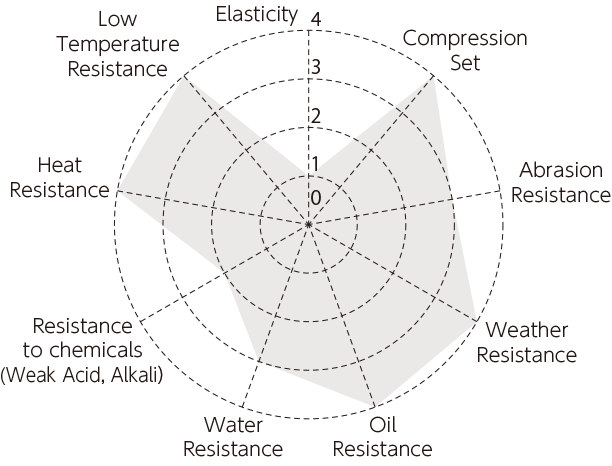1. Characteristics of Wheels(Tire)
The material, hardness and shape of the wheel (tire) determine smooth running performance, starting resistance and revolving resistance.
Rubber, elastomer, and PU are elastic and flexible. Nylon, phenol and polycarbonate are high hardness materials.
Generally, as the wheel size increases and the thickness and flexibility of the tire increase, the noise during travel decreases. On the contrary, when the hardness of the tire is high, the noise during travelling increases.
| Rubber | Nylon | PU | Elastomer | Phenol | Heat Resistant Phenol | Monomer Cast Nylon | Polycarbonate | |
|---|---|---|---|---|---|---|---|---|
| Elasticity | ◎ | × | ○ | ○ | × | × | × | × |
| Compression set | ○ | ◎ | ○ | △ | ◎ | ◎ | ◎ | ◎ |
| Abrasion resistance | ○ | ◎ | ◎ | △ | ○ | ○ | ◎ | ◎ |
| Weather resistance | △ | ◎ | ○ | ◎ | ◎ | ◎ | ◎ | ◎ |
| Oil resistance (machine oil) | × | ◎ | ◎ | × | ◎ | ◎ | ◎ | ◎ |
| Resistance to gasoline | × | ◎ | ◎ | × | ◎ | ◎ | ◎ | ◎ |
| Water resistance | ◎ | ○ | △ | ◎ | ○ | ○ | ○ | ◎ |
| Resistance to chemicals (weak acid, alkali) | ○ | ◎ | × | ◎ | △ | △ | ◎ | (◎、×)※ |
| Heat resistance (℃) | 70 | 70 | 70 | 70 | 120 | 180 | 120 | 120 |
| Low temperature resistance(℃) | -30 | -20 | -30 | -30 | -40 | -40 | -40 | -40 |
- They are general characteristics of materials only. Since materials are affected by factors such as working conditions and environment of caster products, please use this list as guidelines for selecting and determining materials.
- For PU, characteristics of thermoplastic urethane are described.
※Depending on the operating temperature and conditions, it is necessary to change the grease(heat or cold resistance).
-
Rubber Wheels
Rubber wheels are widely used wheels. Stable travelling is possible even on uneven road surface, because surface hardness (rigidity A59 ~ 73) of rubber wheels has low elasticity

-
Nylon Wheel
It is excellent in resistance to chemicals, corrosion resistance, abrasion resistance and light weight. Moreover, it is easy to clean and keep good looking for a long time.

-
PU Wheels
PU wheels have high durability because they are excellent in abrasion resistance and load bearing. It’s also suitable for using in factories as PU wheels are strong in oil.

-
Elastomer Wheels
Elastomer wheels provide elasticity, which is equivalent to that of a rubber wheels, and provides excellent traveling performance even on uneven road surface. It is a material that does not leave traveling marks easily on the surface of floor.

-
Phenol Wheels
It is a material with high rigidity, deformation is least likely to occur even if load is applied for extended period of time. It is also excellent in oil resistance, heat resistance and compression resistance.

-
Heat Resistant Phenol Wheels
It is a material with high rigidity, deformation is least likely to occur even if load is applied for extended period of time. It is also excellent in oil resistance, heat resistance and compression resistance. It can be used up to 180 ℃.

-
Monomer Cast Nylon Wheels
In comparison with nylon wheels, this wheel provides higher load resistance and higher shock resistance. In addition, this wheel provides excellent resistance to higher heat and lower temperature.

-
Polycarbonate Wheels
It is formed by resin integration molding. This wheel provides excellent corrosion resistance and wear resistance. It's characterized by transparent appearance.

2. Rolling and revolving resistance of wheel material
Starting, rolling and revolving resistance of caster are greatly affected by the material of the wheel and the floor.
Soft materials such as rubber, elastomer, urethane, etc. are difficult to roll because of high resistance.
Conversely, high rigidity materials such as nylon, phenol, polycarbonate, etc. become the factor that improve mobility.
◆ Image diagram of rolling and revolving resistance of wheel material

※Starting, rolling and revolving resistance requires confirmation of the following factors.
Wheel diameter, rigidity and elasticity of tire, wheel width (tread surface), eccentricity, bearing, load bearing, floor material, etc.



